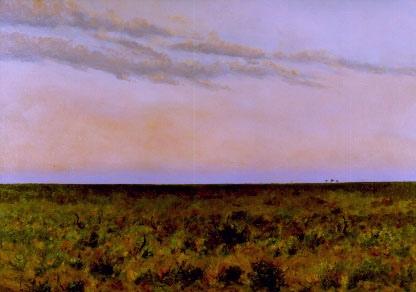Spirit Of The Landscape

published International Artist no: 2 - 1998
|
I always like to walk into the landscape I am about to paint. I will walk into the Sunset, or to the water edge. The Australian Landscape is full of extremes. The harsh, dusty deserts of the inland, the moist secret rainforests and valleys, wild turbulent seas and gentle rolling hills that flow into the sea from coastal rises. The artist who seeks the true inspiration from the natural landscape can never tire of painting this continent. As an artist who loves the natural environment and seeks out the unusual and remote landscape, I will never fully experience in my lifetime those places that I have painted. My still-to-visit list is endless. On my many travels, I like to discover a place and get to know it, become familiar with that landscape. I will not be satisfied with just one visit. None of this get out of the car take a photo and rush back to the studio to paint it. I believe that the best paintings are those which the artist has spent time living a particular environment, breathing the air, experiencing night, day - its very spirit. How can you paint from a snap shot and expect to produce a true sense of place? The land must be felt and lived. There are many similarities between landscape painting and portrait painting. Both are observations of the natural spirit. The portrait artist aims to bring out the inner person, the soul, personality - call it what you will. The landscape artist does the same. A landscape painting is more than just a picture of hills and trees. A good landscape painting should give the viewer a sense similar to that of the portrait, a sense of inner spirit, soul or personality of that land. I have spent a lot of time in various terrains around the country; including the vast Canola & wheat-fields of the Wimmera; the rugged granite outcrop of Mt. Arapiles and its dry white salt lakes; The Little Desert, and its wide diversity of vegetation - low salt-bush, grass trees, banksia forests, abundant wildflowers; the Mallee with its forests of Mallee gums, wonderful salt lakes, including the Pink Lakes National Park where soils containing carotene have turned the salt waters pink, and salt crystals cling to twigs that fall into the waters. All of these places cannot be understood or seen in a day. Many trips back and forth must be made. Camping is an excellent way of experiencing the country, and allows the artist to observe the land in all lights, and the night sky. There is nothing more exhilarating that to sit around a camp fire on a warm evening watching the shiny blackness of the night sky with the glitter of the milky way strewn across the canvas. It is magic to sit on the land and see a meteor shower. It makes you feel good. Close to the earth. It makes you feel inspired and want to paint not only a daytime earthscape, but the night sky as well. It is worth the roughness. After a few days the city can be shaken off, and the dust of the land invades your pores. Whilst camping you are able to experience the full beauty and intensity of the Australian sunset. If staying in a house or hotel or other, you are usually travelling back home while the best show is on! Camping will enable you to continue painting into the twilight. The evening landscape, the setting sun, the first glow and then the second afterglow, when the sun has fallen behind the horizon -these need to be observed for a period of time. Then when you feel it in your bones you can paint it. After beholding the brilliance of the flaming red, gold and orange that streaks the west, it is worth looking away from all the fire, looking instead towards the east at the soft, gentle blues, pinks and mauves of the opposite light. This is sometimes even more beautiful. These gentle colours wash out altogether as the night sky descends into deep maroons and indigos. The first stars appear, and the night revolves into mysterious blues, and then the blackness of the finality of day. The landscape artist must know these hues, the way the various lights fall onto the land, the tones and shapes of the land as the day turns.. A camera snap shot cannot capture all this. I will use the camera as a memory prompter later on - particularly transparencies, which gives a much truer sense of the light's intensity. Sometimes the journey is itself an important part of the process. I live
in Eltham, near Once packed, in the car and on the road, there is a sense of excitement
for the journey ahead. No matter how often you have visited a place before,
there will be something new to discover. I have been to the I have always felt that it is helpful to walk into my subject. If a particular subject inspires me, I will often set up my easel, prepare the canvas and set out into the landscape to absorb the colours and textures. I have found endless subject matter in the Another sources of great inspiration in the During my three-month stay at Parachilna in the Interestingly, despite a three-month stay there, I still do not feel that
I know and understand that landscape. I have been back and forth many times,
usually for stints of only a few weeks, it remains mysterious, new. The
|
|
|
|
|
|
|
Jenni Mitchell - phone: +613 9439 3458 ©2003
email to: jenni mitchell